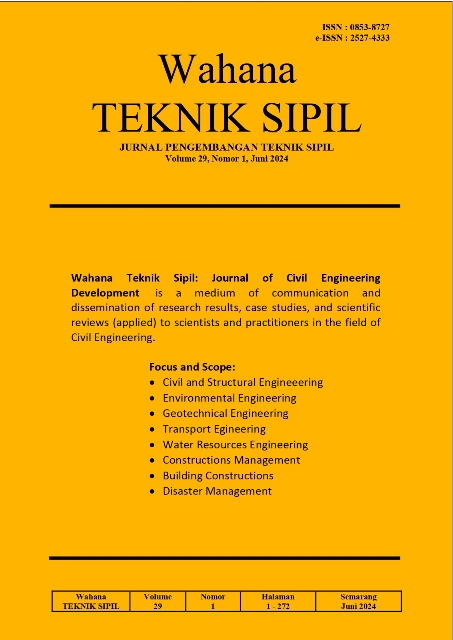ANALISIS KORELASI NILAI CALIFORNIA BEARING RATIO (CBR) DAN NILAI KUAT GESER PADA TANAH LUNAK
DOI:
https://doi.org/10.32497/wahanats.v29i1.5664Keywords:
shear strength, dynamic cone penetrometer test, vane shear, soil bearing capacity, clay soil, design parametersAbstract
The CBR value is influenced by soil gradation, mineral type, density and soil shear parameters. CBR testing is carried out on subgrade soil, but the undrained shear strength of the soil can also be used as a soil design parameter. Field shear strength tests that can be used to determine soil shear strength are DCP and Vane Shear. In contrast to DCP testing, shear strength testing is relatively quick and easy to determine soil properties to determine design parameters. Therefore, testing is needed to determine the correlation between the soil shear strength value and the CBR value to obtain a new equation that can be applied in the field. In this research, the CBR value was obtained through the Dynamic Cone Penetrometer test (DCP) and the soil shear strength of the vane shear test. DCP and Vane Shear testing was carried out at 10 test points in the Semarang area, Central Java. Laboratory testing is also carried out to validate soil types. The correlation obtained between the CBR value and the soil shear strength reached R = 0.8312. Based on this test, it can be concluded that the CBR value and soil shear strength value increase as the depth of the soil tested increases.
References
Danistan, Joseph, C. Vipulanandan, Ph.D., P.E., 2010, “Correlation Between California Bearing Ratio (CBR) And Soil Parameters.” Proceedings CIGMAT-2010 Conference & Exhibition 9 (1): 76”“99.
Gökova, Süleyman, 2022, “Investigation of the Correlation between California Bearing Ratio and Shear Strength of Pavement Subgrade Material with Different Water Contents.” Journal Of Innovative Transportation 3 (1): 1”“7.
Gregory, Garry H., and Stephen A. Cross, 2007, “Correlation of California Bearing Ratio with Shear Strength Parameters.” Transportation Research Record 1 (1989): 148”“53.
Munro, Rosalind, 2018, “International Society for Soil Mechanics and Geotechnical Engineering (ISSMGE).” International Society for Soil Mechanics and Geotechnical Engineering (ISSMGE): 536”“37.
Patel, Mukesh A., and H.S. Patel, 2013, “Laboratory Assessment to Correlate Strength Parameter from Physical Properties of Subgrade.” Procedia Engineering 51 (NUiCONE 2012): 200”“209.
Purwana, Yusep Muslih, and Hamid Nikraz. 2013. “The Correlation between the CBR and Shear Strength in Unsaturated Soil Conditions.” International Journal of Transportation Engineering 1 (3): 211”“22.
Timani, K.L., and R.K. Jain, 2019, “Statistical Assessment of Compaction Characteristics, California Bearing Ratio Value and Shear Behavior of Clay-Sand-Gravel Mixture for Pavements.” i-manager”™s Journal on Civil Engineering 9 (3): 18.
Torgano, Saol Toyebo, Mohammed Sujayath Ali, Esubalew Tariku Yenealem, and Adane Tadesse Tumato, 2020, “Correlation Between Cbr Values and Index Properties of Subgrade Soils: In the Case of Boditi Town.” Ijariie 6 (3): 1167”“82..
Weber, M.,M.R. Lodahl, K.T. Brødbæk, and C.T. Leth, 2021, “Correlation between CBR Value and Effective Strength Parameters for Engineered Fills.” IOP Conference Series: Earth and Environmental Science 710 (1).
Winthachai, S.V., Vaithanomsat P., and Punsuvon, 2022, “Investigation of the Correlation between California Bearing Ratio and Shear Strength of Pavement Subgrade Material with Different Water Contents.” Journal of Innovative Transportation 3 (1): 1”“7.
Downloads
Published
Issue
Section
License
Authors who publish with this journal agree to the following terms:Authors retain copyright and grant the journal right of first publication with the work simultaneously licensed under a Creative Commons Attribution License that allows others to share the work with an acknowledgement of the work's authorship and initial publication in this journal.
Authors are able to enter into separate, additional contractual arrangements for the non-exclusive distribution of the journal's published version of the work (e.g., post it to an institutional repository or publish it in a book), with an acknowledgement of its initial publication in this journal.
Authors are permitted and encouraged to post their work online (e.g., in institutional repositories or on their website) prior to and during the submission process, as it can lead to productive exchanges, as well as earlier and greater citation of published work (See The Effect of Open Access).






